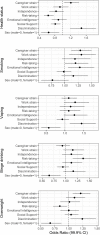Gender-related variables for health research
- PMID: 33618769
- PMCID: PMC7898259
- DOI: 10.1186/s13293-021-00366-3
Gender-related variables for health research
Abstract
Background: In this paper, we argue for Gender as a Sociocultural Variable (GASV) as a complement to Sex as a Biological Variable (SABV). Sex (biology) and gender (sociocultural behaviors and attitudes) interact to influence health and disease processes across the lifespan-which is currently playing out in the COVID-19 pandemic. This study develops a gender assessment tool-the Stanford Gender-Related Variables for Health Research-for use in clinical and population research, including large-scale health surveys involving diverse Western populations. While analyzing sex as a biological variable is widely mandated, gender as a sociocultural variable is not, largely because the field lacks quantitative tools for analyzing the influence of gender on health outcomes.
Methods: We conducted a comprehensive review of English-language measures of gender from 1975 to 2015 to identify variables across three domains: gender norms, gender-related traits, and gender relations. This yielded 11 variables tested with 44 items in three US cross-sectional survey populations: two internet-based (N = 2051; N = 2135) and a patient-research registry (N = 489), conducted between May 2017 and January 2018.
Results: Exploratory and confirmatory factor analyses reduced 11 constructs to 7 gender-related variables: caregiver strain, work strain, independence, risk-taking, emotional intelligence, social support, and discrimination. Regression analyses, adjusted for age, ethnicity, income, education, sex assigned at birth, and self-reported gender identity, identified associations between these gender-related variables and self-rated general health, physical and mental health, and health-risk behaviors.
Conclusion: Our new instrument represents an important step toward developing more comprehensive and precise survey-based measures of gender in relation to health. Our questionnaire is designed to shed light on how specific gender-related behaviors and attitudes contribute to health and disease processes, irrespective of-or in addition to-biological sex and self-reported gender identity. Use of these gender-related variables in experimental studies, such as clinical trials, may also help us understand if gender factors play an important role as treatment-effect modifiers and would thus need to be further considered in treatment decision-making.
Keywords: Biomedical outcomes; Gender measures; Sex differences.
Conflict of interest statement
The authors declare no competing interests.
Figures



References
-
- Wizemann TM, Pardue M-L, editors. Exploring the biological contributions to human health: does sex matter? Washington, D.C: National Academies Press; 2001. - PubMed
-
- Gender, Sex and Health Research Guide: A tool for CIHR applicants. Canadian Institutes of Health Research. 2010. http://www.cihr-irsc.gc.ca/e/50836.html. Accessed 19 Jan 2021.
-
- Fact sheet: Gender Equality in Horizon 2020. European Commission. 2013. https://ec.europa.eu/programmes/horizon2020/sites/horizon2020/files/Fact.... Accessed 19 Jan 2021.
-
- NOT-OD-15-102: Consideration of sex as a biological variable in NIH-funded research 2015. https://grants.nih.gov/grants/guide/notice-files/NOT-OD-15-102.html. Accessed 28 Aug 2020.
MeSH terms
Grants and funding
LinkOut - more resources
Full Text Sources
Other Literature Sources
Medical

